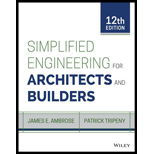
Analyze the
Answer to Problem 1P
The
Explanation of Solution
Given information:
Height of the studs is 9 ft.
The size of the studs is
Use Douglas fir-larch, No. 1 grade.
Wind load on the surface is 17 psf and the gravity load on the wall is
Calculation:
Refer Table 5.1a, “Reference design values for visually graded lumber of Douglas fir-larch” in the textbook for the values of bending
For grade No. 1 Douglas fir-larch, the value of
Refer Table 5.2, “Size adjustment factors (CF) for Dimension lumber, Decking and Timber” in the textbook for the adjustment factor values of
For grade No. 1 and the stud of
Refer Table 5.3, “Applicability of adjustment factors for sawn lumber, ASD” in the textbook for the applicable adjustment factor.
For ASD and load duration, the adjustment factor applicable is load duration factor
Refer Table 5.4, “Adjustment factors for design values for structural lumber due to load duration,
For wind load duration, the adjustment factor is 1.6.
Let assume the wall surface braces the
Determine the ratio of unbraced length of stud
Substitute 9 ft for
Find the buckling stress
Substitute 580,000 psi for
Find the modified design value for compression
Substitute 1,000 psi for
Find the ratio
Substitute
Refer Figure 6.2, “Column stability factor as a function of
For
Refer Table A.8 “Properties of sections” in the textbook for area and section modulus of
The area
Find the stud compression capacity using the relation:
Substitute 1,150 psi for
Find the load P for stud spacing of 24 in. and the gravity load of 400 lb/ft.
The above value shows that the gravity load alone is not a critical concern.
Consider the combined loading:
Find the modified design value for compression
Substitute 1,000 psi for
Find the ratio
Substitute
Refer Figure 6.2, “Column stability factor as a function of
For
For the combined loading,
Substitute 0.25 for
Determine the computed compressive stress
Substitute 800 psi for P and
Wind load is 17 psf. Therefore the load w is,
Find the moment (M) for the wind load as follows:
Here, L is the height of studs and d is the stud distance.
Substitute 12.75 psf for w, 9 ft for L, and 24 in. for d.
Determine the computed bending stress
Substitute
Determine the ratio
Substitute
Apply the code formula for the interaction as follows:
Substitute
The condition satisfied. Therefore, the stud is adequate.
Therefore, the
Want to see more full solutions like this?
Chapter 6 Solutions
Simplified Engineering for Architects and Builders, 12/E (HB-2016)
- 6. A lake with no outlet is fed by a river with a constant flow of 1200 ft3/s. Water evaporates from the surface at a constant rate of 13 ft3/s per square mile of surface area. The surface area varies with the depth h (in feet) as A (square miles) = 4.5 + 5.5h. What is the equilibrium depth of the lake? Below what river discharge (volume flow rate) will the lake dry up?arrow_forwardProblem 5 (A, B, C and D are fixed). Find the reactions at A and D 8 k B 15 ft A -20 ft C 10 ft Darrow_forwardProblem 4 (A, B, E, D and F are all pin connected and C is fixed) Find the reactions at A, D and F 8 m B 6m E 12 kN D F 4 marrow_forward
- Problem 1 (A, C and D are pins) Find the reactions and A, C and D. D 6 m B 12 kN/m 8 m A C 6 marrow_forwardUniform Grade of Pipe Station of Point A is 9+50.00. Elevation Point A = 250.75.Station of Point B is 13+75.00. Elevation Point B = 244.10 1) Calculate flowline of pipe elevations at every 50 ft. interval (Half Station). 2) Tabulate station and elevation for each station like shown on example 3) Draw Sketcharrow_forward40m 150N B 40marrow_forward
- Note: Please accurately answer it!. I'll give it a thumbs up or down based on the answer quality and precision. Question: What is the group name of Sample B in problem 3 from the image?. By also using the ASTM flow chart!. This unit is soil mechanics btwarrow_forwardPick the rural location of a project site in Victoria, and its catchment area-not bigger than 25 sqkm, and given the below information, determine the rainfall intensity for ARI = 5, 50, 100 year storm event. Show all the details of the procedure. Each student must propose different length of streams and elevations. Use fig below as a sample only. Pt. E-ht. 95.0 200m 600m PLD-M. 91.0 300m Pt. C-93.0 300m PL.B-ht. 92.0 PL.F-ht. 96.0 500m Pt. A-M. 91.00 To be deemed satisfactory the solution must include: Q.F1.1.Choice of catchment location Q.F1.2. A sketch displaying length of stream and elevation Q.F1.3. Catchment's IFD obtained from the Buro of Metheorology for specified ARI Q.F1.4.Calculation of the time of concentration-this must include a detailed determination of the equivalent slope. Q.F1.5.Use must be made of the Bransby-Williams method for the determination of the equivalent slope. Q.F1.6.The graphical display of the estimation of intensities for ARI 5,50, 100 must be shown.arrow_forwardQUANTITY SURVEYINGarrow_forward

 Structural Analysis (10th Edition)Civil EngineeringISBN:9780134610672Author:Russell C. HibbelerPublisher:PEARSON
Structural Analysis (10th Edition)Civil EngineeringISBN:9780134610672Author:Russell C. HibbelerPublisher:PEARSON Principles of Foundation Engineering (MindTap Cou...Civil EngineeringISBN:9781337705028Author:Braja M. Das, Nagaratnam SivakuganPublisher:Cengage Learning
Principles of Foundation Engineering (MindTap Cou...Civil EngineeringISBN:9781337705028Author:Braja M. Das, Nagaratnam SivakuganPublisher:Cengage Learning Fundamentals of Structural AnalysisCivil EngineeringISBN:9780073398006Author:Kenneth M. Leet Emeritus, Chia-Ming Uang, Joel LanningPublisher:McGraw-Hill Education
Fundamentals of Structural AnalysisCivil EngineeringISBN:9780073398006Author:Kenneth M. Leet Emeritus, Chia-Ming Uang, Joel LanningPublisher:McGraw-Hill Education
 Traffic and Highway EngineeringCivil EngineeringISBN:9781305156241Author:Garber, Nicholas J.Publisher:Cengage Learning
Traffic and Highway EngineeringCivil EngineeringISBN:9781305156241Author:Garber, Nicholas J.Publisher:Cengage Learning





